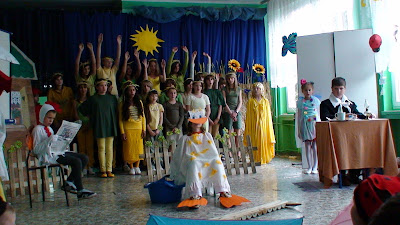 Gullabosleven - the biggest wood ladle in the world
Gullabosleven - the biggest wood ladle in the world
The first the 10-year old Melvin saw when he raised from the ground was a small village with about 50 houses. He saw
Gullabo church from above and he also glimpsed the
big wood ladle, as he used to play by when he was younger. The village looked calm and what stood out the most against the rest of the village was the fresh green, big football pitch, which was situated near
the old railway station and the school of Gullabo.
The helicopter drove through the moisture air and the ground below was mostly covered by forest. The little boy saw at the main road some big lorries drive eastward, he knew because
Bergkvara is situated that way.
Along the main road he could see houses, both occasional and in smaller areas and after a while they started to approach the capital village of the municipality
Torsås. Some big fields spread out and the houses were closer to each other.
Through some treetops he could see a peaceful steam flow, it was the
Torsåsriver.
He could also see
the church of Torsås and its big churchyard. It was Sunday and it was probably worship because the car park was full of cars.
Next to the car park he saw
Ekbacken and its amphie theater. It was the end of April and the grass was newly cut, the wood anemones in the small wooded hillside were almost faded and the oaks were going to get the first leafs of the spring. A man was going to wash one of the windows at one of the small houses in the park of Ekbacken and a lady sat on a bench and watched to the amphie theater. That is where the ceremony of the ending of term is kept, midsummer celebrating and other special things that we celebrate.
Next to Ekbacken Melvin saw a pretty big, light yellow house,
Korrespondensgymnasiet. You can study there even if you live in another country and Melvin thought it sounded great.
Just a bit away from the upper secondary school he saw
Torskolan. The thing that’s special with Torskolan from the other schools in the municipality is that Torskolan has a senior level.
Just a bit away from the school he could see
the big metal cock of Torsås. It is a statue placed centrally in the village and it’s the municipality’s symbol.
The helicopter drove east and before he saw houses so far as the eye could see and now they started to decrease and on his west side he saw two big football pitches. It’s called
Torshammar, which belong to the football club Torsås Goif and Melvin knew that many football games have been played there.
When they drove from Torshammar he watched on his right side. There’s an industry area and suddenly was the asphalt, as he was used to see the ground was full of, become forest and field ground.
A long, brown line went through the small scenery and that’s the walkway
Lionsleden, which goes from Torsås to Bergkvara.
The helicopter flight continued and Melvin saw that a new village was coming closer. They came to Bergkvara and the weather changed from foggy to really nice with sun shining. They kept on the flight east and on Melvin’s right side he could see
the school of Bergkvara and a lot of houses around. They met a screaming seagull and Melvin and his father understood that the sea was close to them. They saw
Skytteholmen and it’s party place and grass blew for the rotary blades and they could feel the wonderful smell of the sea and seaweed and the sea was glinting in front of them. They saw different kinds of boats in the water and some lucky boat owners were going out with their boats for a ride. Some kids went along the beach in
Dalskär with a dog and an old man was going to get the minigolf course on the camping a spring clean. Some swans swam peacefully in the blue water and a bit away there was a lighthouse. Melvin’s dad told him that it was the lighthouse island
Garpen. He took the course that way and when they almost were there, Melvin saw some small, red houses and a big lighthouse. The dad told him that it’s like a hotel, so you can sleep there if you want to. They drove to the village again and in the south of Bergkvara Melvin saw
a brown and white chapel with a bell tower. On a field outside the chapel they parked the helicopter and they walked out in the grass to take a deep breath of fresh air in Bergkvara.
Karolina Erlandsson 8B

























































